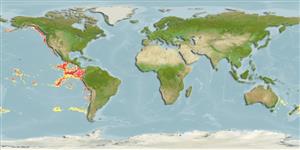Pycnogonida |
Pantopoda |
Phoxichilidiidae
Environment: milieu / climate zone / depth range / distribution range
Ecology
Benthic; depth range 2086 - 3300 m (Ref. 2157). Tropical
Eastern Pacific: Peru and USA.
Length at first maturity / Size / Weight / Age
Maturity: Lm ? range ? - ? cm
Proboscis inflated at both midpoint and distal end. Species has two or three major heel spines larger than sole spines but not nearly as large as heel spines of Pallenopsis californica. Abdomen very long; tibiae with rows of long, slender, lateral setae, and cement gland tube nearly as long as femoral diameter. Chelae conspicuously smaller relative to those of other species (Ref. 2157, p. 4).
Abyssal (Ref. 19).
Life cycle and mating behavior
Maturity | Reproduction | Spawning | Eggs | Fecundity | Larvae
Members of the class Pycnogonida are gonochoric and sexually dimorphic. During copulation, male usually suspends itself beneath the female. Fertilization occurs as the eggs leave the female's ovigers. Males brood the egg masses until they hatch. Life cycle: Eggs hatch into protonymphon larva then to adults.
Child, C.A. 1994 Deep-sea Pycnogonida from the temperate west coast of the United States. Smithsonian Contributions to Zoology 556:1-23. (Ref. 2157)
IUCN Red List Status
(Ref. 130435: Version 2025-1)
CITES status (Ref. 108899)
Not Evaluated
Not Evaluated
Threat to humans
Human uses
| FishSource |
Tools
More information
Trophic EcologyFood items (preys)
Diet composition
Food consumption
Predators
Population dynamicsGrowth
Max. ages / sizes
Length-weight rel.
Length-length rel.
Length-frequencies
Mass conversion
Abundance
Life cycleReproductionMaturityFecunditySpawningEggsEgg developmentLarvae PhysiologyOxygen consumption
Human RelatedStamps, coins, misc.
Internet sources
Estimates based on models
Preferred temperature
(Ref.
115969): 1.7 - 2, mean 1.8 (based on 30 cells).
Price category
Unknown.
